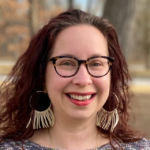In the midst of a global pandemic and racial unrest, Student Achievement Partners took an opportunity to look in the mirror and reconcile with our identity and position within the context of the education system. During a time when trust was at an all-time premium, part of that undertaking included reckoning with our internal guiding principles that stood as defining characteristics of our organizational makeup. Our principles were steeped in power dynamics and white-dominant ideas of professionalism, and no longer served our identity as an organization. We had to redesign them. We wanted new principles that reflected our present and future work in service of becoming an anti-racist, multicultural organization.
Central to the redesign of our principles was moving from managing behaviors to developing people, which was deeply rooted in cultivating a culture of trust, valuing people, and mission-driven work. In identifying these fundamental components, we experienced trust being the most critical lever in dismantling old hierarchical decision-making structures in order to solidify how we understood our roles, our belief systems, and our ways of working together in writing new principles. This understanding allowed us to step into our autonomy in a space where power was openly and transparently shared across roles, prompting our working team to build trust in order to design the principles authentically.
Where Did We Start?
In July 2020, a small internal working team was charged with reworking our principles in any way we saw fit. We could revise, reword, or entirely redo the principles. But we had just under a month to do it. We started by closely examining the characteristics of white supremacy culture, as defined by Kenneth Jones and Tema Okun, and quickly realized two things: 1) that SAP mirrored many of these characteristics in our own culture and principles, and 2) we needed way more than a month to do this work properly.
Still accustomed to our old ways of working, we got to work anyway, and it was bumpy. We realized as we went that we had to work to notice and interrupt our own ingrained sense of urgency and paternalism, as defined by Jones and Okun. We saw this in our own instinct to “ask for more time” when we realized that a month wouldn’t be long enough to codesign as a team or hear from the folks in our organization that we were designing for. Moving from “can we have” or “the deadline is” to “this is what is needed for the work” required a resituating of ourselves and a transformation of our way of working together, even within this task. This very challenge, of recognizing in our working group the very same challenges and ways of working we were tasked with reframing, continued throughout this engagement, creating a microcosm through which to view the shifts we wanted to make. Figuring out how to power share, how to work through discomfort to better our work and our process, and how to leverage the strength of the group was an ongoing challenge, giving us insight into the very practical application of the work we were trying to accomplish.
In interrogating the former principles that had been used by the organization for the past several years, we found that they were a buried document—many people did not use them, and they were not informing our work. However, they did inform our work culture from the top down and it was the folks on the bottom of the hierarchy most directly impacted by that culture.
Getting Others Involved
To lead with equity, we prioritized the most marginalized voices within our organization, conducting empathy interviews with staff who identify as BIPOC and those with the least organizational power.
In our empathy interviews, we asked staff to identify which existing principles resonated with them most, which ones they used most often in their work, and which ones they thought embodied aspects of white supremacy culture. We also asked interviewees how they envisioned new principles informing their work moving forward and whether there were any racial or cultural considerations we should be sure to include in new draft principles.
Simultaneously, we asked the whole organization to share feedback on the existing principles. Having just completed our Organizational Equity Pause, we wanted to give everyone an opportunity to apply their learning and broadened perspectives to work in real time. The team over at Equity Meets Design also provided guidance to ensure we were collecting feedback in the most effective and equitable way possible.
Over the course of three months, we collected an incredible amount of feedback that helped us identify three specific categories that were integral to our work culture: Mission-Driven Work, Valuing People, and Building Trust. Beyond identifying these three categories, though, it was challenging to figure out what to do with all the data at our disposal. We were conflicted about our next steps: as much as we wanted to make progress on the principles, we found ourselves almost waiting for someone to tell us what to do and how to do it.
It wasn’t until we connected with our new Director of Human Resources and the rest of the team actively working on our organizational restructuring that our end goal was solidified for us. Ultimately, the restructuring team had a stronger, more solid vision for how the principles could work for the organization than we ourselves did. Collaborating with them brought the work full circle.
Next Steps
Now that we have a new set of principles, we are finding new ways to use them to inform our work. As part of our restructuring, we have committed ourselves to sharing leadership and power: we work in design teams based on interest and skill set; we now operate with the understanding that we each have agency and decision-making power; and we make space for each other to engage in learning that will contribute to both our individual growth and collective success. There’s still much for us to learn and lots of progress to be made, but we have taken some solid steps to get us closer to our goal of becoming a more equitable organization for everyone.
To read the new principles that guide our work as an organization, click here.




















